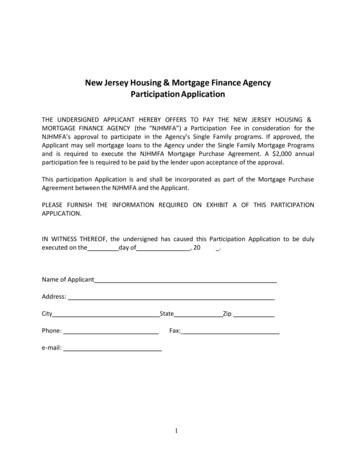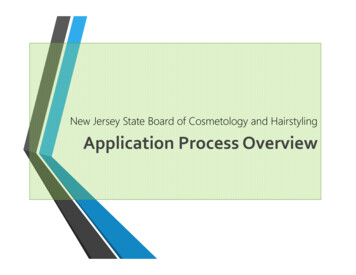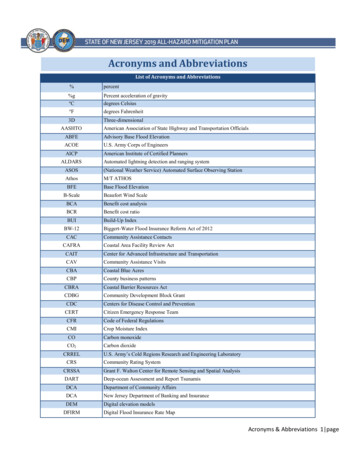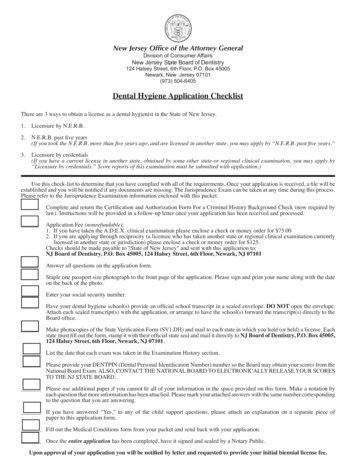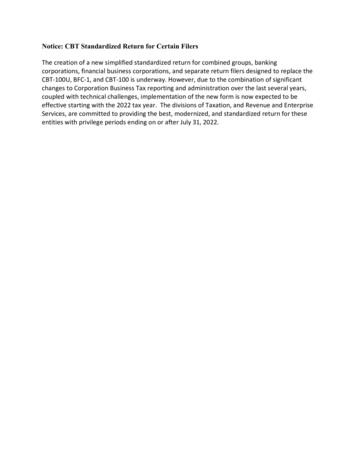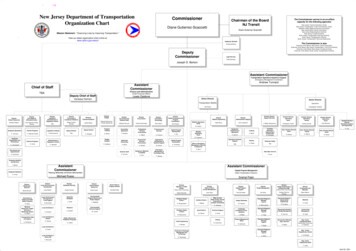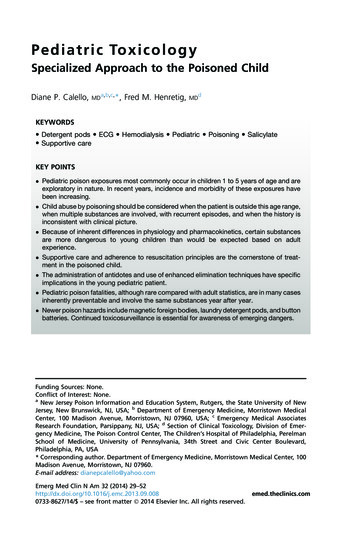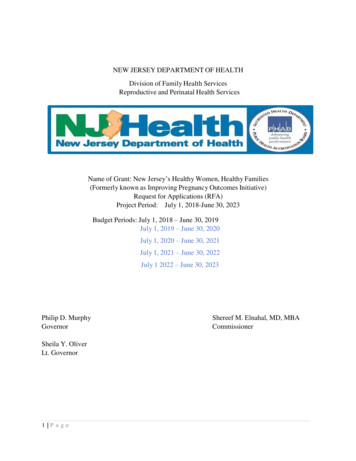
Transcription
NEW JERSEY DEPARTMENT OF HEALTHDivision of Family Health ServicesReproductive and Perinatal Health ServicesName of Grant: New Jersey’s Healthy Women, Healthy Families(Formerly known as Improving Pregnancy Outcomes Initiative)Request for Applications (RFA)Project Period: July 1, 2018-June 30, 2023Budget Periods: July 1, 2018 – June 30, 2019July 1, 2019 – June 30, 2020July 1, 2020 – June 30, 2021July 1, 2021 – June 30, 2022July 1 2022 – June 30, 2023Philip D. MurphyGovernorSheila Y. OliverLt. Governor1 P a geShereef M. Elnahal, MD, MBACommissioner
TABLE OF CONTENTSPAGEI.IMPORTANT DATES . 3II.EXECUTIVE SUMMARY . .3III.INTRODUCTION & BACKGROUND. . 3IV. GOAL/OBJECTIVES, PROGRAM STRUCTURE, ACTIVITIES, OUTCOMES 5V. TARGET POPULATIONS. .11VI. ELIGIBLE APPLICANTS . .11VII. PROJECT REQUIREMENTS . . 12VIII. REQUIRED APPLICATION COMPONENTS AND INFORMATION .13IX. FUNDING . . .15X. TECHNICAL ASSISTANCE MEETING . .16XI. HOW TO ACCESS AN APPLICATION . .16XII. OTHER REQUIREMENTS . . 16XIII. DEPARTMENT OF HEALTH CONTACTS . 17XIV. EVALUATION AND SCORING CRITERIA . 17XV. APPENDICES . . .20APPENDIX A: INFANT MORTALITY DATAAPPENDIX B: LOGIC MODEL TEMPLATEAPPENDIX C: PLAN, DO, STUDY, ACT (PDSA) METHODOLOGYAPPENDIX D: BLACK INFANT MORTALITY INITIATIVES/PROGRAMSAPPENDIX E: HEALTHY WOMEN, HEALTHY FAMILIES REGIONS &PATHWAYSAPPENDIX F: GLOSSARY OF TERMS & REFERENCES2 P a ge
I. IMPORTANT DATESREQUEST FOR APPLICATION RELEASE DATE:APPLICATION OPEN DATE IN SAGE:LETTER OF INTENT SUBMISSION DATE:April 23, 2018April 23, 2018May 17, 2018APPLICATION TECHNICAL ASSISTANCE MEETING May 1, 2018APPLICATION CLOSE DATE IN SAGE:NOTIFICATION DATE:ANTICIPATED START DATE:May 18, 2018June 15, 2018July 1, 2018II. EXECUTIVE SUMMARYEligible Applicants: 1) Agencies that can successfully implement maternal and child healthprograms that focus on health disparities in preconception, prenatal, and interconceptioncare. These agencies should be able to implement referral and case management activitiescountywide. 2) Agencies that have successfully implemented or are able to implementcommunity-based programs that focus on reducing black infant mortality in the followingmunicipalities: Atlantic City, Camden, East Orange, Irvington, Jersey City, Newark,Paterson and Trenton.ii RFA Type: Grant Applicationiii Approximate Number of Awards: Up to twelve (12) awards. Awards vary bygeographical region, proposed project structure, and activities. Please see Table 1 underEligible Applicants for more details.iv Approximate Funding for state fiscal year (SFY) 2019: 4.3 millionv Approximate funding per budget period: Approximate funding amount will vary by region,structure of the program, and activities of the program. See Table 1 under EligibleApplicants for funding ranges.vi Number of years of award: One-year funding with additional 4 yearly continuation basedon agency performance of prior years and availability of funds.iIII. INTRODUCTION AND BACKGROUNDThe New Jersey Department of Health (NJDOH), Division of Family Health Services (FHS),Maternal and Child Health Services is announcing a competitive request for applications (RFA)to support the new Healthy Women, Healthy Families initiative (formerly known as theImproving Pregnancy Outcomes initiative) which is designed for community-based programs toimprove and provide quality access to preconception, prenatal and interconception care forwomen and reduce health disparities in birth outcomes including black infant mortality. HealthyWomen, Healthy Families will achieve this goal through collaborations, outreach, education,care coordination, and implementation of programs that have shown to be successful in reducingblack infant mortality.3 P a ge
Given limited public health resources, funded programs will target activities to statewideareas of highest need with consideration for where the impact will be most significant,particularly in areas with significant health disparities and focus efforts toward high-risk women.High-risk women include women who are low-income and/or uninsured, women with chronichealth conditions, women with multiple social or economic stressors, victims of domesticviolence, individuals impacted by mental health issues, alcoholism and/or substance abuse,women with minimal social supports, women with unintended pregnancies, and women whoexperience any combination of these. These women on average attend fewer prenatal visits andare more likely to experience adverse pregnancy outcomes. Their families are more likely to bewithout a medical home, are less likely to access consistent, comprehensive preventive andprimary care services, and are less likely receive quality care.Improving maternal and infant health and reducing Black Infant Mortality is a priority withinthe NJDOH/FHS prevention agenda especially for those experiencing health disparities due tosocial, economic, environmental/contextual, and behavioral inequities. Key maternal and childhealth indicators (including low birth weight, preterm births, and infant and maternal mortality)have not improved significantly over the last decade in New Jersey, and significant racial andethnic disparities persist.Although the overall infant mortality rate in New Jersey is lower than the national rate(4.7 per 1,000 live births versus 5.9 per 1,000 live births in 2015), the disparity betweenWhite, non-Hispanic (NH), and Black, NH, is significant. In 2015, the infant mortality ratefor White NH was 3.0 per 1,000 births, while for Black NH, the rate was 9.7 per 1,000 births.The infant mortality rate for Black, NH, is more than three times that of White, NH, and thisdisparity has remained constant for at least ten years.Additionally, disparities exist between New Jersey counties and municipalities in termsof Black Infant Mortality rates and other health outcomes (see Appendix A for data).Counties such as Atlantic, Camden, Cumberland, Essex, Hudson, Mercer, and Passaic haveBlack Infant Mortality rates ranging from 6.5 per 1,000 births to 17.1 per 1,000 births. Furtherinvestigation within these counties showed that certain municipalities were really drivingthese high county rates and therefore efforts within these municipalities will be the mainfocus of this grant.There are many potential causes of these disparities, but recent research has highlightedthe effects of social determinants of health such as economic disadvantages (i.e.,underemployment, or unemployment), limited education (e.g., low educational attainment),environmental barriers (e.g., housing instability, structural racism), and social/behavioralfactors (e.g., nutrition and exercise) as major contributors to health outcomes. 1,2,3Addressing these social determinants of health requires a comprehensive, system-leveltransformation that begins at the community level.4 P a ge
IV. GOAL/OBJECTIVES, PROGRAM STRUCTURE, ACTIVITIES, OUTCOMESi.Goal and objectivesThe goal of Healthy Women, Healthy Families is to improve maternal and infant healthoutcomes for women of childbearing age (as defined by CDC as 15-44 years of age) and theirfamilies, especially Black families, through a collaborative and coordinated communitydriven approach. This will be done using a two-pronged approach: 1) county level activitiesthat will focus on providing high-risk families and/or women of childbearing age access toresource information and referrals to local community services that promote child and familywellness and 2) Black Infant Mortality (BIM) municipality level activities that will focus onBlack NH women of child-bearing age by facilitating community linkages and supports,implementing specific BIM programs, and providing education and outreach to healthproviders, social service providers and other community level stakeholders. The objectivesof this RFA are to:Reduce health disparities in preconception, interconception, and prenatal care within thetargeted community, especially those indicators that are closely linked with maternalmortality and infant mortality.Reduce health disparities in birth outcomes and black infant mortality within targetedcommunities.ii.Proposed Project StructureGrants will be awarded for 12 regions of the state. The level of funding for each regionwill be determined by the structure of the proposed project stipulated in this RFA and theexpected activities. The following regions have been established for grant activities:Region 1: Atlantic County/Cape May County AND the municipality of Atlantic CityRegion 2: Bergen CountyRegion 3: Hunterdon County/Mercer County AND the municipality of TrentonRegion 4: Burlington County/Camden County AND the municipality of CamdenRegion 5: Essex County AND the municipalities of East Orange, Irvington and NewarkRegion 6: Middlesex County /Somerset CountyRegion 7: Monmouth County/Ocean CountyRegion 8: Morris CountyRegion 9: Passaic County AND the municipality of PatersonRegion 10: Salem County/Gloucester County/Cumberland CountyRegion 11: Sussex County/Warren CountyRegion 12: Union County/Hudson County AND the municipality of Jersey CityThe proposed project in each region will have a core structure of Central Intake (CI),specifically a Referral Specialist(s), and Community Health Workers (CHWs) that operatecountywide. Six regions (Regions 1, 3, 4, 5, 9, and 12) will also have CHWs that willoperate at a municipality level, conducting BIM reduction activities. Central Intake willONLY be countywide. This RFA will only fund Central Intake in the following counties that5 P a ge
are not funded by the Department of Children and Families (DCF): Essex, Middlesex,Somerset, Passaic, Salem, Gloucester, and Cumberland.Because of the variation in each region’s proposed project structure and activities, fourpathways (A through D) were designed to give applicants the information needed for eachregion. These pathways are defined below in Table 1, under Section VI, on page 11.iii.Proposed Project ActivitiesProject activities will depend on the region and proposed project structure and best reflectthe need of the communities. County ONLY regions will engage in one set of activities. Countyregions that include a BIM municipality(ies) will conduct the core county activities as well asALL BIM activities. Specific activities for “county only” regions and “county plus BIMmunicipality” regions are specified below.a. Regions with only CountiesActivity 1: Implementation of a Referral System through Central IntakeThis RFA will fund counties that are not funded by DCF for Central Intake. This RFA definesCentral Intake as a central location within a region where a referral specialist(s) will be availableto refer and link women of child bearing age (15-44 years of age as defined by CDC) andcaregivers of young children (0 to 5) to needed services within the region. The referral specialistswill be required to work closely with the community health workers within their county andwithin the BIM municipalities that are part of that county, if applicable.Activity 2: Implementation of Case Management Services Through Community HealthWorkersAll grantees must utilize Community Health Workers (CHWs). The Health Resourcesand Services Administration (HRSA) describes CHWs as “lay members of communitieswho work either for pay or as volunteers in association with the local health care system inboth urban and rural environments and usually share ethnicity, language, socioeconomicstatus, and life experiences with the community members they serve.” 4 CHWs will berequired to perform a combination of community outreach and education, home visits, casemanagement, group activities/workshops, and community-based supportive services toprovide a source of enhanced social support and create a bridge between under-served andhard-to-reach populations and formal providers of health, social and other communityservices. They will be trained on the availability of resources within the municipality,county, and the state and gain knowledge on how to navigate different service systems sothat they can be a resource to the community they are serving. Additionally, CHWs willassist in promoting health insurance/Medicaid enrollment so that families in need areconnected to these resources and case manage participants up to three (3) years from thetime of enrollment or until the participant voluntarily terminates from the program. Casemanagement will include, but not be limited to, providing ongoing follow-up andassessment of need. CHWs will be required to collect data on ALL the participants they6 P a ge
are serving and work closely with the referral specialist(s) within their region. Applicantsshould apply for a specific number of CHWs based on documented need and fundingavailability.Activity 3: Diverse Community PartnershipsGrantees must develop diverse community partnerships with non-traditionalcommunity-based providers/agencies with an interest in improving maternal and child healthand mental health by being a resource in implementing project activities/interventions. Atleast 10% of the grantees’ total budget must be subcontracted with community levelorganizations such as minority/multicultural/advocacy organizations, faith-basedorganizations, libraries, community centers, family planning agencies, and other communitydriven agencies. These partnerships are very critical and essential to enhancethe resources available to carry out measurable success and create community support thatis critical to vulnerable, high risk women and children. These community levelpartnerships should be formal and sustainable beyond the grant period.Activity 4: Diverse Community Advisory BoardsGrantees will be required to convene a diverse and inclusive community-based advisoryboard of individuals and partner agencies. The representation must include traditional and nontraditional partnerships of consumers, providers of services, community leaders, andorganizations, including faith-based organizations, with a working interest in maternal and childhealth issues and can contribute to reduction in health disparities and related indicators. It isrequired that at least 25% of members are consumers of services to be rendered as stipulated inthis RFA and who will be active participants in the decision making regarding the direction ofthe proposed project. The Advisory Board will meet at least quarterly to discuss significantissues including barriers to care identified by the participants and develop strategies to overcomethese barriers at a community level. These meetings must be conducive to public participationand must be documented through taking minutes and electronically posting these minutes in anaccessible way.Activity 5: Workforce DevelopmentGrantees will be required to participate in all workforce development opportunities,including trainings by NJDOH and its regional, statewide, federal, and other partners.Grantees will be expected to partner with the One Stop Agencies to recruit staff for theproposed project as well as link with the Rutgers Health Care Talent Network (HCTN) orother institutions of higher education to assist in building workforce needs. All staff mustbe trained to perform the required job duties, especially new components such as casemanagement of Healthy Women, Healthy Families participants.Activity 6: Data Collection and EvaluationGrantees must create an evaluation plan that incorporates both process and outcomemeasures. The evaluation plan must include a LOGIC model and include both process andoutcome measures in the form of inputs, activities, outputs, and short term/mid-term, andlong-term outcomes (see Appendix B for a LOGIC model template). As part of theirevaluation plan, grantees must also demonstrate that they have the capacity and ability to7 P a ge
collect data using tools and methods prescribed by NJDOH and enter this required datawithin a statewide system.Activity 7: Program Monitoring and Quality ImprovementGrantees must incorporate Quality Improvement (QI) activities to critically review theeffectiveness of chosen strategies using a Plan-Do-Study-Act (PDSA) methodology (seeAppendix C for information on this methodology). These QI activities should lead toadjustment of improvement strategies as needed to optimize their effectiveness. Grantees willbe required to participate in NJDOH training and evaluation of these targeted initiatives.b. Regions with Counties AND BIM MunicipalitiesGrantees applying in regions that include a BIM municipality will employ all activities listedabove as well as the following additional activities:Activity 8: Implementation of BIM focused programsGrantees (or their sub-grantees) must implement at least 2 BIM programs that areevidence-based and have shown to be successful in other states or communities to reduceblack infant mortality and other disparities. These programs include:o Group prenatal care such as “Centering” – which provides women with asupportive forum and a longer visit with their health provider and/or theirstaff.o Doula programo Fatherhood initiatives which involves fathers during prenatal and interconceptioncare and promotes family engagement.o Breastfeeding support groups for Black NH women.Go to Appendix D for more specific information and strategies on implementing theproposed projects. Grantees must select one (1) program (Group Prenatal Care or Doula) and one(1) support group (Fatherhood support group or breastfeeding) from the list in Appendix D. If aBIM municipality already has a program/support group being implemented, applicants mustindicate that in the application and explain how these funds will be used to enhance, change,expand, or renew these programs for maximum impact. This will be especially important for thefour municipalities that currently have Healthy Start grants: Camden, Trenton, Newark, andIrvington. Healthy Start is a federal initiative that aims to reduce the rate of infant mortality andimprove perinatal outcomes in areas with a high annual rate of infant mortality.Grantees can implement these programs themselves or subcontract some or all services toother capable agencies. Grantees are encouraged to leverage their resources to collaborate withother community agencies such as family planning agencies for outreach, education, enrollment,and supports.8 P a ge
Activity 9: Community Partnerships to Facilitate Community Supports and AddressCommunity level, Structural RacismWithin the BIM municipality, Activity 3 will be expanded to include partnerships thatspecifically focus on creating community engagement and supports for Black NH womenand their families. These partners must have an interest and the ability to improve BlackNH maternal and child health and mental health and have an understanding of the linkbetween health outcomes and community level, structural racism that exists within theircommunities. These partnerships must include non-traditional agencies such asminority/multicultural/advocacy organizations, faith-based organizations, libraries,community centers, family planning agencies, and other community driven agencies. Atleast 20% of the total budget must be subcontracted with these non-traditional partners.These partners must have the ability to create a supportive system for Black NH womenand their families. These community level partnerships should be sustainable beyond thegrant period.Activity 10: Provide Health Equity/Cultural Competence TrainingGrantees must participate in all trainings offered by NJDOH and its sub-grantees,especially trainings that include information on health inequities and root causes of blackinfant mortality such institutional racism, neighborhood segregation, poverty and the impactof these stressors on health outcomes. In addition, grantees are required to educate localhealth care providers, service providers, and other stakeholders on cultural competentservices and on available resources for high risk pregnant women. These trainings can beperformed at an individual level or as part of a broader outreach.iv.Specific measurable outcomes for the following project structures:a. Programs that include Central Intake and Community Health Workers ORCommunity Health Workers Only ProgramsThe specific outcomes that need to be addressed by applicants include:Preconception careDecrease prevalence of chronic diseases (diabetes, hypertension, asthma, and, obesity)for by 10% annually.Decrease the prevalence of sexually transmitted infections by 10% annually.Decrease the prevalence of substance use by 20% annually.Decrease the percentage of women who experience unintended pregnancies by 10%annually.Pregnancy and Birth outcomesIncrease the percentage of women who receive First Trimester prenatal care by 10%annually.Increase the percentage of women who receive adequate prenatal care by 10% annually.Decrease the percentage of women who deliver pre-term (less than 37 weeks) babies by10% annually.9 P a ge
Decrease the percentage of women who deliver low birth weight (less than 2500g) babiesby 10% annually.Interconception CareIncrease the percentage of women who breastfeed exclusively for at least 3 months by10% annually.Decrease the percentage of women who bedshare with their babies often by 5% annually.Decrease the percentage of women who do not put their babies to sleep on their backs by10% annually.Increase the percentage of women who practice birth spacing of 18 months or more by10% annually.Long Term OutcomeIncrease healthy births.b. BIM municipality programsThe specific outcomes that need to be addressed by all applicants include:Preconception careDecrease prevalence of chronic diseases (diabetes, hypertension, asthma, and, obesity)for Black NH women by 10% annually.Decrease prevalence of sexually transmitted infections for Black NH women by 10%annually.Increase the percentage of Black NH women who receive treatment for a mental healthproblem by 10% annually.Decrease prevalence of substance use by Black NH women by 20% annually.Decrease prevalence of unintended pregnancies among Black NH women by 20%annually.Pregnancy and Birth outcomesIncrease the percentage of Black NH women who receive First Trimester prenatal careby 10% annually.Increase the percentage of Black NH women who receive adequate prenatal care by 10%annually.Decrease the percentage of Black NH women delivering pre-term (less than 37 weeks)babies by 10% annually.Decrease the percentage of Black NH women who deliver low-birth-weight (less than2500g) babies by 10% annually.Interconception CareIncrease the percentage of Black NH women who breastfeed exclusively for at least 3months by 10% annually.Decrease the percentage of Black NH women who bedshare with their babies often by5% annually.10 P a g e
Decrease the percentage of Black NH women who do not put their babies to sleep ontheir backs by 10% annually.Increase the percentage of Black, NH women who practice birth spacing of 18 months ormore by 10% annually.Long-term outcomeDecrease Black infant mortality rates within the targeted communities.V. TARGET POPULATIONSThe target populations for the county level activities include high-risk women ofreproductive age (15-44 years of age as defined by CDC) and caregivers of young children (0-5).The target populations for the BIM Municipality activities are Black NH women of reproductiveage who are pregnant, about to be pregnant or post pregnancy and Black NH caregivers of youngchildren (0-5).VI. ELIGIBLE APPLICANTSThere are four pathways to becoming a Healthy Women, Healthy Families grant recipient.Table 1: Pathways for ApplicantsPathway APathway BPathway CPathway DCentral I ntake (e.g. Referra lSpeci al i st) & Communi tyHeal th WorkersCommuni ty Heal th WorkersCommuni ty Heal th Workers and BI MprogramCentral Intake (e.g., Referral Speci al i st),Communi ty Heal th Worker, a nd BIMprogram Monmouth/Ocea n Bergen Morri s Sus sex/Warren Mi ddl es ex/Somers et Sal em/Glouces ter/Cumberl and Es sex & East Orange Ci ty /I rvi ngton/Newark Pa ss a ic & Paters on Ci ty Uni on/Huds on & Jersey City Hunterdon/Mercer & Trenton Burl i ngton/Camden & Camden Ci ty Atl anti c/Cape May & Atl anti c Ci ty Impl ementa ti on of ReferralSpeci al i st Impl ementa ti on of Cas eManagement Servi ces for upto 3 years Communi ty Partnershi ps Communi ty Advi sory Board Workforce Devel opment Data Col l ecti on andEval uati on Program Moni tori ng and QI I mpl ementati on of CaseManagement Servi ces for up to 3years Community Partners hi ps Community Advi s ory Board Workforce Devel opment Data Col l ecti on and Eval ua ti on, Program Moni tori ng and QI I mpl ementati on of Case Ma nagementServi ces for up to 3 years Community Partners hi ps Community Advi s ory Board Workforce Devel opment Data Col l ecti on and Eval ua ti on, Program Moni tori ng and QI I mpl ementati on of BIM progra m (e.g.,Doul a) Community Partners hi ps that focus ons upports for Bl a ck NH women Cul tural Competence/Heal thy Equi tyTrai ni ng I mpl ementati on of Referral Speci al i s t I mpl ementati on of Cas e Ma nagementServi ces for up to 3 years Community Partners hi ps Community Advi s ory Board Workforce Devel opment Data Col l ecti on and Eval ua ti on, Progra m Moni tori ng and QI I mpl ementati on of BIM progra m (e.g.,Doul a) Community Partners hi ps that focus ons upports for Bl a ck NH women Cul tural Competence/Heal thy Equi tyTrai ni ngStructureEligible RegionsActivities% of Budget toCommunityPartnersFunding Ranges10%75,000 to 350,00010%250,000-300,00020%400,000 to 1,000,00020%350,000 to 600,000Applicants can apply for multiple regions and as a result, multiple pathways. The pathwaysdescribed above are dependent on the region, proposed project structure, and activities. Pathway11 P a g e
A includes regions where applicants must create a program that includes Central Intake andCommunity Health Workers. Pathway B includes regions that require applicants to create aproject that includes Community Health Workers only. Pathway C includes regions that requirean applicant to create a project that includes both county level and municipality level CommunityHealth Workers and BIM projects (from Appendix C) and community supports for Black NHwomen/families. Pathway D regions require applicants to create a project that includeseverything from Pathway C with the addition of Central Intake. For a visual depiction of theregions and pathways, go to Appendix D.The selection for grant awards is a competitive process and is contingent on the potentialgrantee's ability to meet the following eligibility requirements:Agree with NJDOH Terms and Conditions for Administration of GrantsAgree with conditions stated in this RFA.Have the capacity in terms of workforce and expertise and reach to implement thisprogram.Eligible applicants include but are not limited to not-for-profit agencies, local healthdepartments and other agencies that provide dedicated maternal and child healthservices and that meet the requirements of this RFA.All applications that meet the minimum requirements will undergo a review process,as described below.Any applicant that has been disbarred or is under suspension by the NJDOH or othergovernmental agency is not eligible.All information submitted with the application is subject to verification during thereview by NJDOH staff.Verifications may include but are not limited to credentials of staff, progress reportssubmitted to funders, fiscal policies, procedural policies (including culturalcompetency policy) and procedures, etc. Submission of unverifiable information inthis proposal may result in an agency not receiving any funds.VII. PROJECT REQUIREMENTSInfrastructureDepending on the regions selected, applicants will structure their project according tothe pathways described in Table 1, Section VI. Applicants may apply for multiple regionsand hence use multiple pathways; however, all applicants must incorporate communityhealth workers within their project structure.In addition, applicants must demonstrate the ability to administer and oversee theprogram by: Recruiting, engaging, and supporting individuals as CHWs and train themappropriately. Facilitating participation in workforce development by all staff, including CHWs;12 P a g e
Case managing participants up to 3 years or until participants voluntarily terminatefrom the project.Creating community level supports/partners that are funded, formal and informaland effective and sustainable.Those applicants with Central Intake will be required to use the Single Point of EntryClient Tracking (SPECT) System to refer women and families to county and municipalitylevel resources.ImplementationThe work plan, with timeline, should be included in the application. The work planshould address the specific objectives that are based on the measurable outcomesstipulated above as well as how each activity stipulated above will be incorporatedeffectively.All grantees will provide screening, linkages, and follow-up to services that addressinequities in a number of areas including the following (adapted from
Reduce health disparities in preconception, interconception, and prenatal care within the targeted community, especially those indicators that are closely linked with maternal mortality and infant mortality. Reduce health disparities in birth outcomes and black infant mortality within targeted communities. ii. Proposed Project Structure


